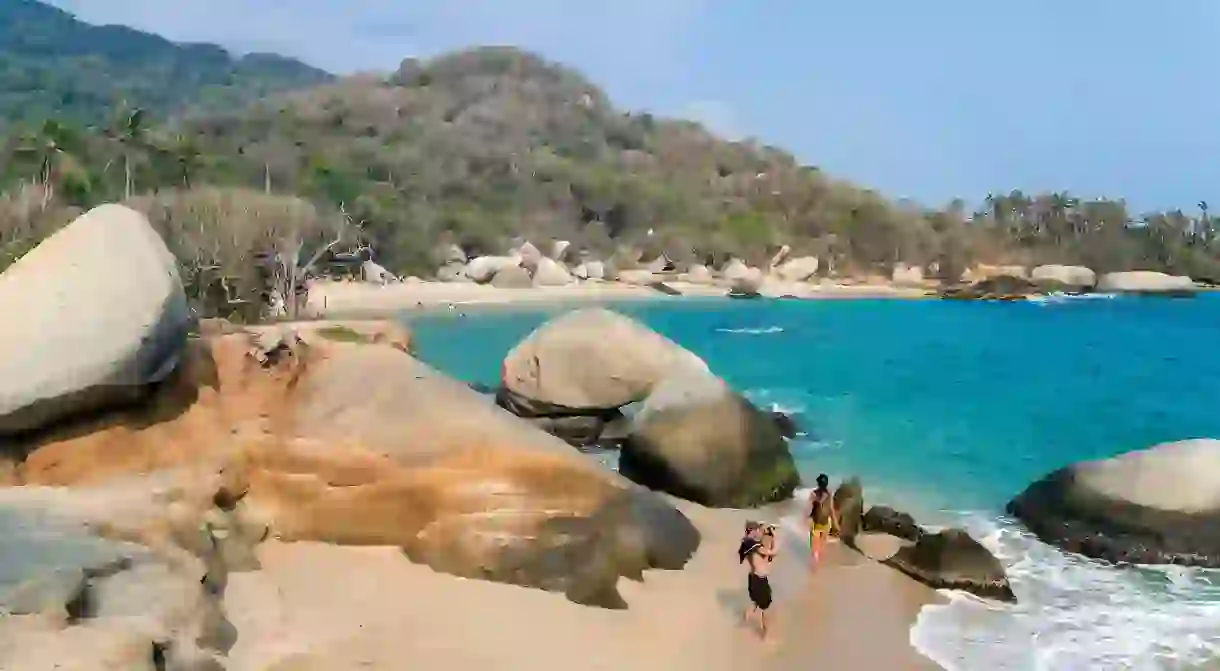The Best Places to Visit in Colombia

Colombia was a relatively underexplored tourist destination not so long ago, but that’s changed significantly in recent years – and it’s easy to see why. From the culturally rich cities of Bogotá and Medellín to the spectacular landscapes of the Andes and Caribbean coast, Colombia has a huge amount to offer. Here, we’ve hand-selected the best places to visit in Colombia.
With Culture Trip, you can visit Bogotá, Medellín and the Zona Cafetera on our specially curated eight-day Colombian Andes adventure – or trace the Caribbean coastline from Cartagena to Palomino on our exclusive eight-day Colombian Caribbean trip, guided by our Local Insider.
Bogotá
Architectural Landmark

At 2640m (8661ft) above sea level, Bogotá is the fourth-highest altitude capital in the world. This vibrant city is brimming with cultural attractions: admire the eclectic street art on show in La Candelaria – Bogotá’s oldest barrio – learn about the country’s heritage at the National Museum or Gold Museum or sample delicious street food and fresh fruit at markets such as Paloquemao and La Perseverancia. For panoramic views overlooking the city, head to Mount Monserrate – you can reach the top in an hour on foot, but if you don’t fancy the steep ascent then take the funicular or cable car.
Medellín
Architectural Landmark

Medellín, nicknamed the ‘City of Eternal Spring’ for its pleasant year-round climate, has undergone a dramatic transformation this century. Regarded as one of the world’s most dangerous cities during the 1990s, it has emerged from the conflict-ridden Pablo Escobar-era to become a trendy metropolis, fuelled by technological innovation. A guided walking tour is the best way to appreciate how the city’s troubled past has evolved into a much brighter present. Take the Medellín Metrocable – gondola system connecting the center with hillside barrios – to see the city from above.
Zona Cafetera
Natural Feature

Colombia’s Unesco-listed coffee-growing region – the Zona Cafetera – covers the departments of Caldas, Risaralda, Quindío and Tolimo and features some of the country’s most picturesque scenery. Think undulating hills covered in a patchwork of coffee plantations, banana trees and bamboo along with colorful, little villages. Plenty of fincas offer immersive tours and tasting experiences here, too. If hiking is your thing, head to Cocora Valley near Salento – renowned for its gigantic Quindío palm trees or Los Nevados National Park – characterized by snow-capped volcanoes, glaciers, lakes and forests.
The Caribbean Coast
Architectural Landmark, Historical Landmark

Colombia’s Caribbean coast encompasses pristine beaches, dense jungle, vast desert and charming cities. Visit Cartagena – known for its atmospheric walled city – and plan to day-trip to the idyllic Rosario Islands or San Basilio Palenque, the first free African town in the Americas. Continue east along the coast to the Tayrona National Park, where you can hike through the rainforest, swim in secluded lagoons and visit ancient indigenous villages. Elsewhere, the harsh, arid terrain of La Guajira, in the northeast corner – on the border with Venezuela – offers a striking contrast.
Magdalena River Valley
Natural Feature, Architectural Landmark

Flowing 949mi (1528km) from the high Andes to the Caribbean Sea, the Magdalena River and its surrounding floodplains contain some of the most biodiverse ecosystems in the world. These rainforests, wetlands and swamps are home to Magdalena River turtles, brown spider monkeys, South American tapirs, jaguars and a myriad of other species –many of which are sadly critically endangered due to severe habitat destruction. The river was a key strategic route for Spanish conquerors when they arrived in the early 16th-century – establishing towns such as Honda and Mompox, which are worth visiting for their wonderfully preserved colonial architecture.
The Amazon Region
Park

The Pacific Coast
Natural Feature

Colombia’s Pacific Coast is relatively unexplored, given much of the region can only be accessed by boat or dirt track. Many of the settlements are inhabited by Afro-Colombian communities, whose ancestors arrived in the region as slaves under Spanish colonial rule. As it’s often overlooked on most Colombia itineraries, you’ll discover off-the-beaten-track ecotourism destinations and wild, unspoiled nature here. Nuquí, El Valle and Bahía Solano offer the best choice of accommodation – along with superb surfing, scuba diving, snorkeling and whale watching opportunities.
La Macarena National Park
Natural Feature, Park

La Macarena National Natural Park sits at the confluence of three ecosystems: the Amazon, the Andes and the grassy plains of Los Llanos. The dry shrublands, rainforest and rugged mountain terrain are home to pumas, anteaters, red howler monkeys and thousands of more species. The park’s crown jewel is the remote Caño Cristales – also known as the ‘River Of Five Colours’ for its rainbow-like complexion – which is difficult to get to but worth the trouble. Your best bet is taking a direct flight with Satena from Bogotá and joining an organized tour when you’re there.
El Cocuy National Park
Natural Feature, Park

Jardín
Architectural Landmark

Jardín – founded in 1864 – is a small town in Antioquia, 80mi (130km) south of Medellín. Its kaleidoscopic colonial houses, neo-Gothic church and delightful cafés make it a worthwhile getaway from Medellín – or as a detour en route to the Zona Cafetera. From the town center, take a cable car to an observation point for panoramas of the surrounding area. If you’re up for an adventure, follow the hiking trail to La Cueva del Esplendor – a cave with a large hole in its ceiling that forms a gushing waterfall from the river above.













